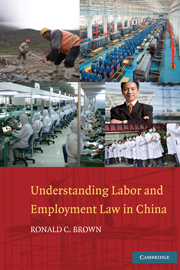Book contents
- Frontmatter
- Contents
- Preface
- Acknowledgments
- Understanding Labor and Employment Law in China
- PART I UNDERSTANDING CHINA'S REGULATION OF THE WORKPLACE
- PART II EMPLOYMENT RELATIONSHIPS
- PART III HIRING AND EMPLOYMENT PRACTICES
- PART IV WORKING CONDITIONS, WAGES, AND HOURS
- PART V EMPLOYEE BENEFITS: LEAVES, MEDICAL, MATERNITY, WORK-RELATED, UNEMPLOYMENT, AND PENSION INSURANCE
- PART VI DISCIPLINE AND TERMINATION UNDER EMPLOYMENT AGREEMENTS
- PART VII RIGHTS, REMEDIES, AND MULTIPLE FORUMS
- Appendix
- Index
Preface
Published online by Cambridge University Press: 22 January 2010
- Frontmatter
- Contents
- Preface
- Acknowledgments
- Understanding Labor and Employment Law in China
- PART I UNDERSTANDING CHINA'S REGULATION OF THE WORKPLACE
- PART II EMPLOYMENT RELATIONSHIPS
- PART III HIRING AND EMPLOYMENT PRACTICES
- PART IV WORKING CONDITIONS, WAGES, AND HOURS
- PART V EMPLOYEE BENEFITS: LEAVES, MEDICAL, MATERNITY, WORK-RELATED, UNEMPLOYMENT, AND PENSION INSURANCE
- PART VI DISCIPLINE AND TERMINATION UNDER EMPLOYMENT AGREEMENTS
- PART VII RIGHTS, REMEDIES, AND MULTIPLE FORUMS
- Appendix
- Index
Summary
China now has its legal system in place, and in recent years it has assembled substantive laws and regulations that govern the workplace, the employment relationship, and the contractual and statutory rights and benefits of its workers. As China moves ahead to raise the legal standards and levels of coverage and enforcement in these areas and its social security safety net, it also seeks to balance its very successful economic growth and competitive advantages especially as these relate to labor. Employers face increasing obligations and technical legal requirements, which in earlier years did not exist or at least were not consistently enforced. The current global economic downturn now puts added pressures on China to maintain advancement in labor and employment laws.
Although the Labor Law was issued in 1994 with its broad outlines and promises of regulation, the more substantive labor and employment laws were not issued and put into operation until the mid-2000s.
Suddenly, in the mid-2000s, Wal-Mart was unionized and the Chinese trade union, the All China Federation of Trade Unions (ACFTU), launched organization drives aimed especially at the Global Fortune 500 companies doing business in China. Early draft provisions of the new Labor Contract Law sent the American Chambers of Commerce reeling and arguing that the new labor laws and added regulations and costs would drive American companies out of the country. The discussion was so intense that the Chinese government raised issues about foreign interference in China's affairs.
- Type
- Chapter
- Information
- Understanding Labor and Employment Law in China , pp. xi - xiiPublisher: Cambridge University PressPrint publication year: 2009

